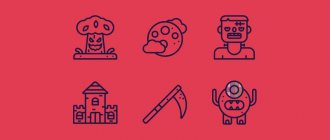0 1574 April 21, 2021 at 07:04 pm Author of the publication: Evgenia Astreinova
People's fears are a huge palette. There are widespread ones: fear of the dark, dogs, thunderstorms, air travel, fear of visiting the dentist. There are also the most unusual fears among people: fear of vegetables, clouds, buttons. The general list of human fears known today is a long alphabetical list of hundreds of varieties. Where do people's fears come from, what is their reason?
A person is one who is able to feel
Have you ever seen a fish with an anxiety disorder, a sparrow in mortal anguish, or a toad in a panic attack? Rational nature controls animals through a coordinated intraspecific instinct. This allows each species to safely survive and reproduce. We are not talking about any “sentiments” here.
The only one whom nature has endowed with a sensual form of life is man. We gladly accept this gift when emotions bring pleasure. When we soar on the wings of love, we experience tenderness and passion, inspiration and joy.
Another thing is human fears, this “dark side” of our sensuality. No one wants to shake when they see spiders, panic when trying to leave the house, or suffer from epileptic seizures when boarding a plane. In modern human life, fears significantly limit our capabilities. They narrow the ability to live every available moment with joy.
And here we have many questions for nature. Is fear a natural emotion or an unnecessary burden? Why are we created this way?
3. Fear of not distinguishing your desires from imposed ones
When you feel like you are living someone else’s life: you are doing something unnatural for you or are overly irritated - carve out an hour or at least thirty minutes for yourself.
- Turn off your phones.
- Sit down and carefully look at the landscape outside the window.
- Ground yourself: Be in the present.
- Consider what the weather is like today, feel what you are wearing.
Films about psychology: the largest selection, enough for a year
Why does a person need emotions?
Nature's plan for humanity is also infallible and rational, it's just different. Our ability to empathize and sympathize with each other is one of the mechanisms for uniting humanity. And ultimately serves to ensure that we successfully preserve ourselves as a species.
But becoming a compassionate and empathetic person is a process. It begins with the fact that in the human community there appear people who are capable of experiencing the first, very vivid and powerful emotion - the fear of death. To this day, this root emotion underlies our ability to feel and experience any other emotional state.
About people's fears as the basis of our sensuality
People who were the first in the human community to be able to experience emotions are carriers of the visual vector. It was a feature of their psyche to experience a vivid emotion: fear of death.
This fear, in the course of long evolution, was transformed into the ability to empathize, sympathize and sympathize with another person. By gradually creating emotional connections with other people, those with the visual vector brought love into this world. The entire human species has become capable of experiencing emotions.
The most emotional people
Despite the fact that today every person has sensuality, our ability to experience emotions remains different. Those who were given the properties of the visual vector from birth were and remain people with the widest emotional range. The state of such a person can change in a short time from unbridled euphoria to mortal melancholy.
The viewer’s natural desire is to love and be loved, to have warm emotional connections with everyone around him. But the ability to empathize is not innate: initially, in childhood, the root emotion arises - the fear of death. And each little viewer goes through their own individual “evolution of emotions” (from fear to love and empathy) from birth to puberty. He gradually learns to fear not for himself, but for others, that is, to empathize. This is an important stage of psychosexual development. But not always everything goes well in this process.
It happens that even in childhood the viewer was recorded in a state of fear. For example, adults scared people and read scary fairy tales. Or they were forbidden to cry or show emotions. Then the natural desire to love and be loved does not go away, but it is much more difficult for a person to realize his sensual potential. In this case, you can only open your soul to the one with whom you are building a relationship up to a certain stage, and then fear and discomfort arise, the cause of which you cannot understand. There may be a feeling that you can be ridiculed, hurt your soul.
Based on childhood psychotraumas, we also have bad experiences. It only strengthens a person in the desire to keep a distance from others, not to open his heart to anyone.
To some extent, this precaution keeps us from receiving new mental pain. But for some reason such a life does not bring joy. The enormous sensory range remains largely confined within man. Not understanding what is happening, the viewer becomes hostage to strong changes in their emotional states. These can be periodic hysterics, throws from despair to euphoria. And of course, these are people’s most vivid fears, anxiety disorders and even panic attacks.
What are visual people afraid of?
Fear of death can manifest itself in different ways, in different forms. For example, some people are afraid of getting an incurable disease, others are afraid of being hit by a car or crashing on a plane, etc. Moreover, the rich imagination of the viewer can instantly draw pictures in their head with any terrible and bloody details.
Fear of the dark is also common among visual people, and there are evolutionary reasons for this. Sensitive vision protects from danger only in the light. And in the dark it is powerless: it is impossible to see who is hiding there, under the bed.
Fear can even be associated with some emotional episode or a scary story heard in childhood and repressed into the unconscious.
But there are also special, “specific” fears that arise in people with a different mental structure.
When to see a doctor?
Fear is not always useful, and in some cases it is recommended to seek help from a specialist. Reasons for seeking medical help may include:
- Panic attacks, especially those that occur for no apparent reason.
- Inability to engage in work or household activities and other daily activities due to fear and phobias.
- Constantly being in a state of fear for no apparent reason.
- Severe deterioration in physical condition due to fear.
- The appearance of fear against the background of other somatic (for example, bronchial asthma) or mental (schizophrenia) diseases.
- Sleep disorders.
If you have phobias, fears of specific things or circumstances, you should seek help from a psychologist or psychotherapist. It is also recommended to consult a specialist in this profile if you have groundless but controllable fears.
Before visiting a doctor, certain preparation and analysis of your condition is recommended. They will simplify the process of diagnosis and choice of treatment tactics. It is useful to prepare the following data in advance:
- All the symptoms that accompany the feeling of fear, even if they seem unrelated to the emotions experienced.
- Triggers are things, people, factors or external circumstances that provoke feelings of fear and anxiety.
- Reactions and methods of counteracting fears and phobias, including the results of their use.
- Previously experienced severe emotional shocks or stressful periods.
- A list of all medications, nutritional supplements and vitamins that are taken, as well as their doses.
About people’s fears depending on mental properties
Our psyche has 8 vectors. Each of them may have its own specific fear. Here are some examples:
- The strongest fear of a person with a sound vector is the fear of going crazy, of losing control of consciousness.
A sound engineer is the owner of abstract intelligence. He connects himself, his I, not with the body, but with the soul (his feelings) and consciousness (thoughts). The sound artist is drawn to the knowledge of the intangible. He is interested in how all observable reality is structured and by what laws it is governed. Since childhood, he has been asking questions about why everything around him exists and why he himself lives.
Finding answers to questions involves first and foremost the ability to think clearly. Mental illness deprives the sound artist of the ability to think, understand, be aware and thus fulfill his unique role for all humanity. Therefore, “not thinking” is the same as “not being” for the owner of the sound vector. Hence the fear of going crazy.
- The biggest fear of a person with an anal vector is the fear of disgrace.
Owners of such properties are the most loyal members of society. Their main values are respect and honor. They, like no one else, care what other people think about them, what assessment they give to their behavior and actions.
Accumulating and transmitting knowledge to others is the natural role of carriers of the anal vector. Therefore, stressful situations for them are exams and test work. Or, for example, a report where you need to share experience and knowledge with other people, that is, a public speaking. In such situations, the fear of disgrace can manifest itself very strongly.
The fear of disgrace sets not only psychological characteristics, it is also associated with physiology. By nature, those with such properties have a special sensitivity to the anal sphincter. At times of extreme stress, they may experience stool retention. But in anticipation of stress, on the contrary, diarrhea occurs. Therefore, it is not uncommon that before an important presentation or test, a carrier of the anal vector runs to the restroom many times. And his fear of disgrace also hiddenly carries in itself a completely direct physiological meaning: it is the fear of losing control over the anal sphincter of the body at the wrong moment.
- About the fears of people with the skin vector. Special tactile sensitivity and sensitive skin are a special sign of such a person.
Skin people are afraid of becoming infected with something through touch, of catching an infection through the skin. Skin people are susceptible to such conditions under severe stress and prolonged lack of fulfillment. These are ambitious people, striving for property and social superiority. They can experience severe stress due to demotion or material losses. And persistent severe conditions arise when, over a long distance, such a person is systematically unable to achieve his ambitious goals.
When fear takes on an obsessive form, then the carrier of the skin vector fanatically washes his hands after touching any objects. Treats them every minute with an antiseptic, even while sitting at home.
So, in each of the 8 vectors, people’s fears are unique and they are connected with the structure of their psyche and with their special erogenous zones.
What is the person experiencing?
Every person is afraid of something, but not everyone has phobias. In psychology, a phobia is considered a pathologically increased manifestation of the fear reaction to a stimulus.
Signs of a phobia:
- panic;
- shiver;
- cardiopalmus;
- suffocation;
- feeling of heat;
- sweating;
- often - ringing in the ears.
Fear is not associated with a specific threat, but with a specific situation. The reaction of the human body may be such that it is impossible to move, and numbness sets in. Fears are 2 times more common in women than in men. Sometimes various anxiety states are also called phobias, although this is not entirely true.
It happens that children or women, wanting to be the center of attention, begin to be afraid of something, and gradually this becomes a habit. Sometimes a particular phobia causes a feeling of strong disgust, for example, to spiders or worms.
What phobias exist, and why are people scared of so many things? The reasons for this are memory, imagination and speech. It was a large number of fears and concerns that helped humanity survive and move forward. Obsessive fears vary in intensity. Despite their senselessness, coping with them is sometimes difficult. Existing phobias are systematized alphabetically, their names are in Greek and Latin.
Is it possible to live without fears
Any, even the most insignificant fears of people reduce their ability to live joyfully and happily. What can we say about phobias, panic attacks and similar forms of persistent and long-term fear.
It is possible and necessary to live without fear. Despite the fact that evolutionarily fear is the foundation of our ability to feel, for a modern adult it is a sign of psychological distress. This can be easily seen using simple real-life examples.
In ancient times, the fear of being eaten saved the life of the entire flock. Under the influence of a strong emotion, the heartbeat and breathing increased, a special muscle tone arose: the body was preparing to flee.
Today, the owner of the visual vector saves people’s lives in a completely different way. Feeling empathy and compassion for people, he often chooses humanistic professions (doctor, social worker). Or he participates in volunteer projects, saving the lives of the seriously ill and wounded, and takes care of the elderly and children.
But when a visual person suffers from psychological trauma received in childhood, cannot fully reveal his abilities in the profession, or experiences overstress, his psyche is subject to strong fears. When we sweat from fear, our hearts race and our breath takes away, we are not bringing any benefit to society. Predatory animals have not threatened us for a long time, but man himself suffers, not understanding the root and cause of the problem.
The situation is similar in any other vector of our psyche. For example, a realized, without psychological trauma, owner of the anal vector normally handles stress during a test test or during a public speech - he is simply calmly focused on doing his job perfectly, without mistakes.
Fear that there won't be enough time
Do you have children? If not, then look at what lifestyle moms and dads lead. Parenthood is a vivid example of the fact that life can contain much more than it seems at first glance. In fact, raising children is a second profession. Troublesome, labor-intensive and costly both in time and money. However, millions of incredibly busy moms and dads are finding opportunities.
Some claim that they even enjoy being parents. Anyone who has embarked on the path of change should learn from parents with their ability to find time and energy for their children. And parents prove that time can be found to solve any problem.
Which of the 12 fears are you familiar with? How do you deal with it? Share in the comments.
How fears go away
For owners of any combination of vectors, fears go away if:
- A person reveals the entire nature of his psyche, the full set of his psychological qualities and properties. On average, a modern city dweller is a carrier of 3–5 vectors at the same time.
- There is an awareness of the hidden causes of the problem: psychological trauma, false attitudes and anchors that a person has received throughout his life. When the causes of problems are realized, fear ceases to control a person.
- When psychological hindrances go away, a person gets the opportunity to fully realize all the talents inherent in nature. This becomes a prevention of any negative conditions in the future.
Author of the publication: Evgenia Astreinova
The article was written based on materials from the training “System-vector psychology”
Fear of conflict with society
When we begin to change, society often offers the greatest resistance. Coming into conflict with society is scary. Nevertheless, many of the norms dictated by society look absurd these days. Judge for yourself.
- Everyone should finish school. Think about what school knowledge has been useful to you in life? Do you remember the periodic table? How is a pistil different from a stamen?
- Our universities are the best in the world. What can you compare them to? Are you ready now to spend five years on the monotonous development of a specialty that may not be in demand in the future?
- Everyone is required to work five days a week. How much do meetings with colleagues help in your development? What do you do when you get stuck in traffic on the way to work?
As you can see, there is no absolute truth. Realizing this fact, it is no longer so scary to argue with mythical social norms and go your own way.
"Tomorrow"
How many times have you been planning to start a new life, but put this step off until tomorrow? Remember, the right time will never come. If you need a magic kick, consider this article to be it. It's your time to change your life.
"I can not afford it"
Do not pay attention to the opinions of others or to your own doubts when choosing a place of residence, a profession, a hobby, or a new partner in life or business. If you are an adult, then you are able to take care of your mental comfort on your own. This means that you have the right to choose those things and activities that you think suit you best.
Fear of mice and rats
Various types of fears develop in 14% of people at one stage or another in life. They can be harmless or cause health problems. Inspired phobias are considered the most dangerous. Suspicious people are more susceptible than others to the fear of getting sick. It is called pathophobia, or nosophobia. Severe fear can cause imaginary pain. Sometimes you can get out of this state only with the help of antidepressants. Nosophobes, getting rid of a non-existent disease, tend to self-medicate and this can seriously harm their health.
Phobias are studied by doctors, biologists, psychologists, philosophers, theologians, and linguists, each presenting them in their own way with many comments related to their profession.
There are fears caused by animals - zoophobia. People experience fear of various animals: spiders, cockroaches, snakes, dogs, cows, but most often mice (musophobia) and rats (zemmiphobia).
If the fear has gone very far, a person becomes sick from the sight of not only living rodents, but even Mickey Mouse, depicted in drawings, in the form of figurines or on a T-shirt. Zemmyophobia includes the fear of rats and moles. It may be caused by disgust at the sight of these animals. Zemmyophobes believe that they are planning an attack and will attack at any moment. Scientists believe that the fear of mice has long been passed down from generation to generation at the genetic level, as a warning about the danger of losing food supplies and contracting diseases.










